Columns
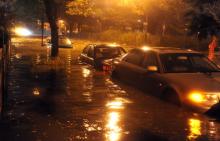
IF IT WASN'T the year from hell for the North American continent, it was the year from a place with a very similar temperature.
It's hard to remember, but it began with that bizarre summer-in-March heat wave that meteorologists described as one of the most anomalous weather events in the country's history. Before long there were record blazes burning in Colorado and New Mexico, and then a stifling heat wave moved east, triggering a "derecho" storm that raced almost 1,000 miles from Indiana to the Atlantic and left 5 million without power. July was the hottest month ever recorded in the United States; it was also when drought descended full force on the Midwest, stunting corn and soybeans and driving the world price of grain up by 40 percent (and making sure our hellish year became traumatic for poor people the planet round). By August it was clear we were in for a record melt year in the Arctic; when the long polar night finally fell, it was clear we'd essentially broken one of the planet's biggest physical features. And all that was before Sandy piled into our greatest urban area, leaving behind an indelible image of the future.
So the question becomes, what's an appropriate response? What even begins to match the magnitude of the trouble we face? What doesn't seem like spitting in the wind?
My sense is that the time has come to take on the fossil fuel industry itself—not the members of Congress they buy in droves each election season, but the real powers. Ignoring the damage they've already caused, these people spend hundreds of millions of dollars each day looking for new fossil fuels. And they spend hundreds of millions each year making sure no government stops them. They're like the tobacco industry at this point, except that instead of going after your lungs they're going after the lungs of the planet.

In the dark days of Advent, we wonder when the birth pangs will end: Will light break into the darkest corners of our hearts, our families, our lives? Will God—can God—take the twisted sinew of our warped world and redeem it? Will we—can we—hold on through the night? Can we trust that light to come? These are the questions of Advent.
As we enter the season of Epiphany, new questions arise: Will we allow the light that has broken forth to illuminate the darkest corners of hearts, our families, and our lives? Can we—will we—follow Jesus as he untwists the mangled metal of our shattered souls ... and redeems it? Can we—will we—trust the light or will we hide from it? These are the questions of Epiphany.
The light of Epiphany illuminates in two directions: It flashes inward, revealing our twisted and fragmented souls, and it flashes outward, revealing the carnage and consequences of the lies our world has embraced and used to craft public policy, the lies we have believed and reinforced through our complicit acceptance, and the truth we must speak.
As we enter 2013, we look back and see that over the past four years much public good was done. Remember: The Lilly Ledbetter Fair Pay Act made it easier for women to fight pay discrimination. Remember the drama when Congress passed the Affordable Care Act and the Supreme Court upheld it, creating a path for tens of millions of Americans to finally receive health care. Remember the image of the last troops leaving Iraq.
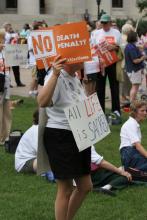
I AM AGAINST the death penalty in principle. The deliberate killing of prisoners does not demonstrate our society's respect for life, which we are trying to teach—especially to those who violate it. We simply should not kill to show we are against killing. It's also easy to make a, yes, fatal mistake, as alarming DNA testing has demonstrated, revealing some death row inmates to be innocent. In addition, the death penalty is clearly biased against poorer people, who cannot afford adequate legal representation, and is outrageously disproportionate along racial lines. The facts are that few white-collar killers sit on death row, and fewer are ever executed. And there is no evidence that capital punishment deters murder; the data just doesn't show that.
At a retreat I attended a couple of years ago, conservative activist Richard Viguerie approached me and said, "Jim, let's do something together to really shake up politics." Viguerie had become a friend, so I asked him what that might be. "I am a Catholic," Viguerie said. "I am against the death penalty, and I think it's time for conservatives and liberals who agree on that to begin to work together." I was fascinated at the thought of unlikely partners helping to accomplish that together. So we have had several dinner meetings over the last two years with both conservative and liberal leaders—mostly people of faith—to discuss the issue.
Here are some basic facts. There have been 1,312 executions since 1976, when the death penalty was reinstated following a 10-year moratorium. There were 43 prisoners killed in 2011, and 35 so far in 2012. As of April 2012, there were 3,170 people on death row. Forty-two percent are black, 43 percent are white, and 12 percent are Latino. Thirty-three states have the death penalty; 17 have abolished it and several have abolition legislation pending. Since 1973, 141 people have been exonerated and set free from death sentences because of new evidence—people who shouldn't have even been prisoners and were almost killed by the state due to false or faulty evidence. Eighteen of them were released because of DNA evidence. Who knows how many people have been executed unjustly?

BELATED CONGRATULATIONS to Jesus Christ after recent research revealed that he might have been married during his short life. (Although, if he had to help with the dishes every night, it might have seemed longer.)
My immediate reaction was to wonder what you get a deity for a wedding present, even though it’s way too late. Their Pottery Barn listing is probably out of date, but that might be for the best, since all the cheap stuff would have been taken by now. (My oldest daughter is getting married next year, so I speak from experience that you’ve got to get in there fast and sign up for that salt shaker. Otherwise, you’re stuck buying an entire set of towels, or a food processor. She’s my daughter, but one must draw the line.)
Trying to get your head around the idea that the shortest verse in the Bible should be “Jesus wed,” the whole thing seems a little farfetched, but you can’t argue with possible science. Harvard Divinity School professor Karen L. King claims that a 4th-century papyrus fragment, written in the Coptic language of Egyptian Christians at the time, makes a reference to Jesus’ “wife.” King presented her findings at a recent gathering of the International Congress of Coptic Studies, which doesn’t seem like the kind of gathering that generates much Twitter traffic, unless there’s a private party in one of the rooms. (“Would you like to come upstairs and see my papyrus fragments?”)
From what I can tell by the photos, the handwriting on the fragment looks like a shopping list I’d hurriedly written out and then couldn’t read when I got to the store. Not having the foresight to bring along a Coptic translator, I’d invariably forget that one thing the family really needs. I wonder if Jesus had to put up with the same condescending looks when he brought home the wrong stuff. Okay, probably not.

HILDEGARD BLEW in on a late summer storm. Sleek and ebony, eyes a bright chatoyant gold. Between the Supercans and downed tree limbs, she was scratching up worms, plucking at bugs. In this nation’s capital of a little more than 600,000 souls, a loose hen was highly unusual—but there she was, in all her Gallus gallus domesticus glory.
Of course, she didn’t arrive with the name Hildegard. And certainly not Hildegard von Chicken, after a favorite Rhineland mystic. That came later. After she’d been interviewed and photographed for the DCist news blog; after she’d become a destination point for recently migrated hipsters; and after a woman running for local office asked if she could take Hildegard on the campaign stump to make her candidacy “more memorable.”
Hildegard received her name after a chance encounter with La Señora at the 11th street bus stop. “I rescued a chicken,” I told her. “What color?” she shot back.
La Señora is in her 70s and from Paraguay. She is knowledgeable about many things. “Black ... with a green undersheen,” I said. “This is very good. You have most likely rescued it from a religious ritual where it would be sacrificed for evil intentions.” “Wow!” I replied. “What should I do?” La Señora stared at me a moment: “You must pray the rosary with the chicken. Hold her and pray the rosary.”
THIS WAS THE series of curious events that led to my being perched on porch steps on a hill in the imperial city of Washington, D.C., holding my grandmother’s rosary and praying with a chicken, whose name I decided should be Hildegard, “Sybil of 11th Street,” because she was consulted by so many of high and low estate.
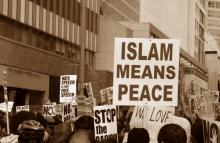
AS I WRITE this, the top story on The New York Times website reads “Anti-American Protests Over Film Expand to More than a Dozen Countries.” The slideshow includes images of angry young men with their fists in the air and masks over their faces protesting on dusty streets filled with riot police and open fires. As if Americans’ view of Muslims was not dark enough.
The film in question is the 14-minute YouTube clip called Innocence of Muslims that portrays the Prophet Muhammad as a buffoonish clown and even a child molester. It was created and promoted by individuals with a long history of anti-Muslim activities, who were perfectly aware that it would provoke a small segment of Muslims around the world to violence. And it is now that violent response that is defining the Muslim world to many people—just as in the case of the attacks of 9/11 and the riots provoked by the Danish cartoons in 2005. As @TheBigPharoah said on Twitter: “The sad thing is that those who attack embassies are like hundreds, barely a thousand. Millions are tarnished by what they do though.”
It is impossible to overstate how frustrating it is to be constantly represented by violent thugs and to be asked to explain their actions. Here is the question one African-American seminary student I recently met asked me over email: “Why do so many Muslims ... become so enraged when someone from the West deliberately breaks an Islamic rule they take as offensive?”
I’VE ALWAYS LOOKED forward to Advent. It’s a time each year of expectant hope—the hope brought by the coming of a child, born in an animal stall in Bethlehem, who would change everything. It is the time of year when I am reminded again of the choice we always have between cynicism and hope. That’s ultimately a spiritual choice, and Advent is a formative season that nurtures the choice to hope, which can guide our decisions and actions.
This fall, Sojourners launched a new project called Emerging Voices, and it’s one of the most hopeful initiatives I have been involved with in a long time. It aims to mentor, develop, and promote the most dynamic up-and-coming communicators—speakers, preachers, and teachers—who are called to lead and publicly articulate the biblical call to social justice.
The vision for this project is exciting and something to be celebrated. It also calls to mind a critical observation: Our world often wants saviors, not prophets; new messiahs, not leaders. We want heroes with superhuman strength who save the day, not mere mortals who speak the truths we typically don’t want to hear. Even the modern-day giants of social justice—Dr. Martin Luther King Jr., Dorothy Day, and Mahatma Gandhi, for example—were at best prophets, but never saviors.
It’s easy to slip into the mentality that one person, one voice, will rise up in a generation, and that she or he will change the world as we know it. Dr. King spoke of this temptation as the “drum major instinct.” It is the basic desire of humans to lead the charge and, ultimately, reap the recognition—or, at the very least, to place our confidence in a single human being.
THE SKIES LOOK different to me these days. The soft and tranquil clouds of my youth that often reminded me of cute Disney characters—a misty Dumbo drifting languidly overhead—have mostly been replaced by dark and threatening formations, more reminiscent of Disney’s lesser-known films, such as Godzilla vs. The Little Mermaid: This Time It’s Personal. More specific, the violently roiling skies of late are like a scene from Steven Spielberg’s War of the Worlds, where intense storm clouds heralded an alien invasion.
Which is why I always carry a prepared speech of surrender in my backpack, in case I need to immediately declare loyalty to a superior race. Although, so far, the alien presence has been pretty unimpressive, consisting mainly of crude, humanoid Kardashians attempting to assimilate quietly. One hopes that when the next prototypes arrive, they will better conceal the vaguely reptilian features of their planet’s indigenous life forms. Not to mention vice presidential hopeful “Paul Ryan,” whose hairline displays the telltale widow’s peak once thought to be a unique facial characteristic of earthly vampires, until NASA rovers spotted it on a rock on Mars. (Mars reportedly privatized its health care for seniors decades ago, and just look at the place now: not an elderly person in sight.)
BUT WHAT WAS I talking about? Oh yes, the weather. The typical forecast this summer included phrases such as “hurricane-force winds,” “damaging hail,” and “start hoarding toilet paper.” Of the four mature trees in our yard, only one remains, having survived repeated gale-force winds through pluck and attitude, although having a trunk the circumference of a grain silo probably helped. (I could never get my arms around it for a hug, back when I used to do that sort of thing.)

“LOTS OF COMPANIES do rotten things in the course of their business—pay terrible wages, make people work in sweatshops—and we pressure them to change those practices,” says veteran anti-corporate-abuse leader Naomi Klein. “But these numbers make clear that with the fossil-fuel industry, wrecking the planet is their business model. It’s what they do.”
The numbers she’s referring to are straightforward—they were first put forth in a report by a group of U.K. financial analysts a year ago, and they’ve now begun to seep into the debate about climate change. They show that if we have any hope of keeping the increase in global temperature below the 2 degree Celsius line (a goal so conservative that even the U.S. and Chinese governments have embraced it as their target), we can only emit 565 more gigatons of carbon dioxide. But the fossil-fuel industry, it turns out, has 2,795 gigatons worth of carbon in its inventory—that is, five times what it would take to run the Genesis creation story backwards.
In other words, this is not a case of “bad business practices.” It’s not like Apple paying bad wages or making workers use dangerous chemicals. Those are deplorable, and correctable—they’re what the boycott or the shareholder resolution was invented for. That’s how we’ve fought everything from grape growers to sweatshops.
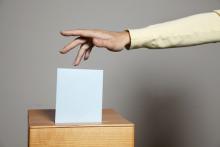
ELECTIONS CAN BE challenging times for nonprofit organizations, especially those of us deeply committed to social change. Sojourners is incorporated under the IRS Code as a 501(c)(3) organization, which means that we are prohibited from “directly or indirectly participating in, or intervening in, any political campaign on behalf of (or in opposition to) any candidate for elective public office.”
While scrupulously avoiding “intervening” in any partisan activities, we of course remain committed to our mission, which is to “articulate the biblical call to social justice, inspiring hope and building a movement to transform individuals, communities, the church, and the world.”
Those two poles—staying neutral in partisan campaigns, on the one hand, and working to build a movement to “change the world,” on the other—define the space within which we work, during an election year and at any other time.
We believe that elections matter—especially, from a biblical point of view, because they profoundly affect those that scripture calls the “least of these,” the likelihood of war or peace, and the health of our planet. (See Jim Wallis’ article “How to Choose a President” for more on that theme.) And many of us have strong convictions about which candidates, and which party’s approach, better reflect those biblical commitments.
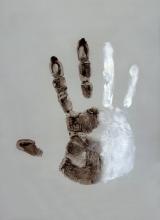
RACE WAS THE issue that changed the direction of my life. Growing up in Detroit in the early 1960s, the realities of white racism upended the world and church that I lived in.
What I saw and heard as a teenager painfully showed me that something was terribly wrong with my country and my religion. Trying to confront it got me virtually kicked out of my childhood church, led me into the civil rights and student movements, introduced me to the black churches, and set me on a path that would eventually bring me back to the good news of the gospel of Jesus Christ—which calls for social, racial, and economic justice. The historical tragedy, the “original sin,” of white racism in the United States is still a fundamental starting point to how I see the world.
So when I look at this election involving the first African-American president in U.S. history, I can’t help but go back to the critical questions of race. Let me be clear: To disagree with policies of President Obama and his administration is not racist. Agreements and disagreements are just that, and should not be correlated to race. And regardless of how we vote, we should all appreciate the fact that the role model of the Obama family living in the White House has convinced millions of young black men and women, and youth of all races—many for the first time—that they are really a part of this country and that they too could someday be president of the United States.
But I am concerned about how race has again distorted our politics. I want to speak directly to what those racial politics are and how people of faith should call them out and oppose them, no matter how we vote or what we think of the policies of the president.

A FEW YEARS back, Sojourners editor-in-chief Jim Wallis and I did a talk together at Northwestern University. After the event, the line to see Jim was dozens of people long. They wanted him to sign their books, to offer encouragement on their new social justice projects, to meet their kids, to give pastoral advice on a problem they were having. Jim talked to each and every one of them, some for several minutes. It delayed our dinner by at least an hour.
As we were finally sitting down in the restaurant and tucking in to our salads, I asked Jim why he stayed for so long. Why not do what so many other public figures do—leave right after your part of the show is over?
“I am a preacher and a pastor,” he answered. “An important part of my vocation is spending loving time with individuals. The period right after a public talk is an excellent opportunity to do that.”
“Plus,” he added, with a twinkle in his eye, “listening to other people’s stories may be the best part of this work.”
I just hit the 10-year mark of running Interfaith Youth Core, and the 15-year point of my first involvement with interfaith work. I haven’t logged as many miles or given as many speeches as Jim, but my schedule tends in a similar direction. The image of him talking to all those young people after that event at Northwestern sticks in my mind every time I board an early flight or prepare for a day of workshops followed by a late-night keynote.
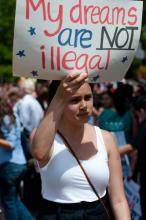
THIS SUMMER, in a historic development, nearly 150 evangelical leaders signed an “Evangelical Statement of Principles for Immigration Reform.” Signers came from across the spectrum of evangelicalism, from leading Latino evangelical organizations to pastors Max Lucado, Bill Hybels, Joel Hunter, and Jim Daly, president of Focus on the Family.
No, that isn’t a typo. Sojourners stood side by side with Focus on the Family to draw attention to the plight of millions who have been caught up in a broken system. It was exciting to see a unity across the traditional political spectrum that rarely happens in Washington.
Make no mistake: There are still big gaps in theology and politics among those in the group. But rather than politics, we focused on the things we agreed were fundamental moral issues and biblical imperatives. Instead of ideology, we came together because of morality and common sense.
Big things don’t change in Washington first; they change in the nation’s capital last. You’d think that with all the lobbyists on K Street and the billions of dollars being spent, Washington must be the country’s most important place. But this is the place where things don’t change, where politics maintains the status quo and the special interests maintain their own interests. Both Republicans and Democrats are more concerned with their political bases and getting re-elected than with the people and families whose lives are being crushed.

EVER SINCE THE apostles positioned Mary Magdalene as an “unreliable narrator” telling an “idle tale” in Jesus’ resurrection story, some men in the church have claimed maleness as normative and orthodox and femaleness as, well, not.
In the recent case of the Vatican vs. the Leadership Conference of Women Religious (LCWR), the integrity of women’s witness is, once again, called into question by male hierarchs.
These Catholic sisters represent an unbroken, cohesive expression of faith in the history of American Catholicism and in women’s presumption of equality, completeness, and active moral agency both under law and under God—a presumption that is a shining light for women around the world. The sisters might have once shared accolades for faithful servant leadership with their brother priests, bishops, and cardinals, but over the course of nearly 30 years of unfolding pedophilia scandal and blasphemous mob-like cover-up, the laity has learned to look to the sisters alone for examples of Catholic gospel witness and Christian maturity, strength, and just plain grit.
But let’s not sideline this issue as “a Catholic thing.” We don’t get off that easy. The struggle over women’s authority runs right through the denominational diaspora of the body of Christ.

SEVEN AMERICAN women sat at a long rectangular table with 10 pastors from rural communities in Eastern Congo to learn about the pastors’ work of healing and reconciliation. A brilliant World Relief translator moved seamlessly from Swahili to French to English as we jotted notes.
“When Marcel from World Relief first gathered local pastors together, we were suffering,” one pastor said. “But he reminded us that, even in circumstances like these, the church has a crucial role to play. All the victims in our communities are people given to us to care for.”
Local church pastors in the North Kivu region of Congo face personally all the sufferings common to members of their communities: murder of family members by armed militias; rape of mothers, wives, and daughters as a weapon of war; displacement from their homes because of local conflict; an economy based on subsistence farming destroyed when crops are burned or uprooted by marauding rebels.
But their personal suffering doesn’t invalidate their biblical call to “care for the least of these.” Marcel, formerly a local Congolese pastor, works with World Relief Congo to serve local pastors by providing training in leadership, community transformation, trauma healing, and conflict resolution.
The pastors’ first challenge was to create committees representing every denomination and tribe in the region. The committees meet monthly to determine who in the community is most in need—a family with nothing to eat, a widow without shelter, a victim of sexual assault who needs hospital care. Sometimes the most needy are church members; sometimes they aren’t. It doesn’t matter.

AS AN AUTHOR whose book sales have, shall we say, peaked, I took particular interest in the rising popularity of Just Love: A Framework for Christian Sexual Ethics, by Catholic Sister Margaret Farley. Until recently, her book had enjoyed only modest success, the predictable result of a title that gets the public’s blood racing with “sexual,” then quickly disappoints with the word “ethics,” the marketing equivalent of taking a cold shower while wrapped in a wet blanket. Toss in the word “Christian” and your sales possibilities are further reduced to a half dozen seminary students still looking for a thesis topic.
All of which violates the advice my grandmother gave me years ago: “Put sex in a book title, honey, and it’s money in the bank.” At least I think it was my grandmother.
But then a miracle happened. When officials at the Vatican read the book—between pensive walks in long robes (that’s what they do in the movies)—they were shocked and stunned, and immediately (six years later) declared it scandalous. This caused sales of Just Love to skyrocket. (Which proves the other thing my grandmother said: “No wait. I got it wrong. Have the Vatican criticize your book and then it’s money in the bank.”)
Vatican officials objected to Sister Farley’s frank theological exploration of modern sexuality which, anyone could have told her, is just not done when affiliated with a powerful religious institution that thinks “modern” means “the most recent part of the Middle Ages.” And back then, people didn’t talk about gay marriage or masturbation or any of the other issues Sister Farley thoughtfully ponders, not without enjoying the church’s hospitality sitting in wooden stocks for a few days.

I have been a Little League baseball coach for both of my sons’ teams for many years. And I’ve learned that baseball can teach us life lessons.
Just a few weeks ago, my 9-year-old’s team was down 5-0, and we had already lost our first two games. It didn’t look good. But all of a sudden, our bats came alive; all our practice and preparation suddenly showed itself. Best of all, our rally started in the bottom half of the order, with our weakest hitters. Two kids got on with walks, and our least experienced player came to the plate. With international parents, he had never played baseball before, and you could tell he didn’t have a clue. But somehow he hit the ball, and it went into the outfield. Our first two runs scored, and he ended up on second base. Being from a British Commonwealth culture, he began to walk over to the shortstop and second baseman and shake their hands! “Stefan,” I shouted. “You have to stay on the base!” “Oh,” he said. “I’ve never been here before.”
Inspired, other kids who had never got hits before also got them now. Then the best hitters started to hit, and we came back to win 11 to 6. In a long team meeting afterward, the kids couldn’t stop telling each other what they had learned. “We didn’t give up, and we came back!” “Our rally started with the bottom of the order.” “Sometimes you get what you need from unexpected places.” “We all just kept cheering for each other.” “Everybody helped us win today.” Finally, our star player said, “This just goes to show you: You can’t ever give up on hope. We always have to keep on hoping no matter what.”
This is central to our vocation in the churches: to offer unexpected hope, because our mission is to the kingdom of God—“thy kingdom come, thy will be done, on earth as it is in heaven.” That is what we pray. And while the kingdom of God was the central message of Jesus and the New Testament, it has faded as ours. Finding salvation to heaven is part of the message, getting closer to God is part of the message, but the heart of the message of Jesus was a new order breaking into history—changing everything about the world, including us.
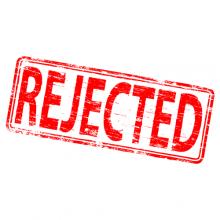
THE TAR SANDS in Alberta, Canada, have been in the news a lot lately, since they appear to be a promising source of energy for the United States, a nation hungry for a fuel derived by despoiling pristine forests, fouling fresh water sources, and enriching oil executives. (Nobody said capitalism would be pretty. Cute and cuddly, perhaps, but not pretty.)
Actually, I’m not familiar with this new type of energy source. Is it the tar we want, or the sand? Probably not the tar, since it’s too sticky and is mainly used as a preservative for saber-toothed tiger skeletons in California, something I learned in an eighth grade history book with lots of pictures. (I like pictures.)
So it must be the sand, which one day our cars will run on, to which I must add: Are our scientists brilliant, or what?!
Unfortunately, extracting this energy source domestically could be a direct threat to our beaches, the nation’s principal source of sand. Which is why I plan to Occupy the Beach of My Choosing later this summer, and stand in powerful protest—or, after a heavy picnic lunch, lie on a blanket in powerful protest—against exploiting this valuable resource.
Come to think of it, Saudi Arabia has lots of sand. So maybe we can get it from them.

All our life should be a pilgrimage to the seventh day; the thought and appreciation of what this day may bring to us should be ever present in our minds. For the Sabbath is the counterpoint of living; the melody sustained throughout all agitations and vicissitudes which menace our conscience; our awareness of God’s presence in the world.
—Abraham Joshua Heschel
The Sabbath
IF THE SEVENTH day is the Sabbath of my week, August is the Sabbath of my year. For most of my life, August has meant vacation. As a child, my parents would pack my brother and me into the station wagon, head to the ferry dock on the Connecticut side of Long Island Sound, and float across the water to the Hamptons, where my mother’s best friend, Patti, lived.
August meant long days in the sun at the beach and long dinners around Patti’s table with fresh zucchini, snap peas, tomatoes, and corn from the farm stand down the road. Some days—some of the most magical of my childhood—before dinner, Patti would hand me a little metal bucket and lead me across her gravel road to a bramble-laden field where we’d pick blueberries.
Nearly 40 years on, the muscle-memories I have of plucking those indigo gems from their prickly rests have not faded a bit. While I usually collect my blueberries these days from Trader Joe’s, I still pick through the berries as Patti taught me to, looking for the few errant green stems left behind by the processing plant.

HEY PRESIDENT OBAMA: The Nobel Peace Prize committee is calling. They want their medal back.
The coveted award, which many felt was premature, at best, when bestowed during the president’s first year in office, was seriously tarnished in the eyes of many by his escalation of the war in Afghanistan and other military endeavors.
But Obama’s role in waging drone warfare—particularly in Pakistan and Yemen—has made a mockery of the prize that Alfred Nobel said should go to the person “who shall have done the most or the best work for fraternity between nations.”
Obama’s drone attacks—according to a May investigation by The New York Times, Daniel Klaidman’s new book Kill or Capture, and other sources—are arguably in direct violation of U.S. and international law, and immoral to boot.
The drone attacks started out with clear rules: Only target those who represent a direct threat to the United States. Those rules soon went out the door—a senior U.S. official called it a “little liberalization that went on in the kill lists,” according to The Washington Post, while a former counterterrorism official said that “the elasticity of that has grown over time.”